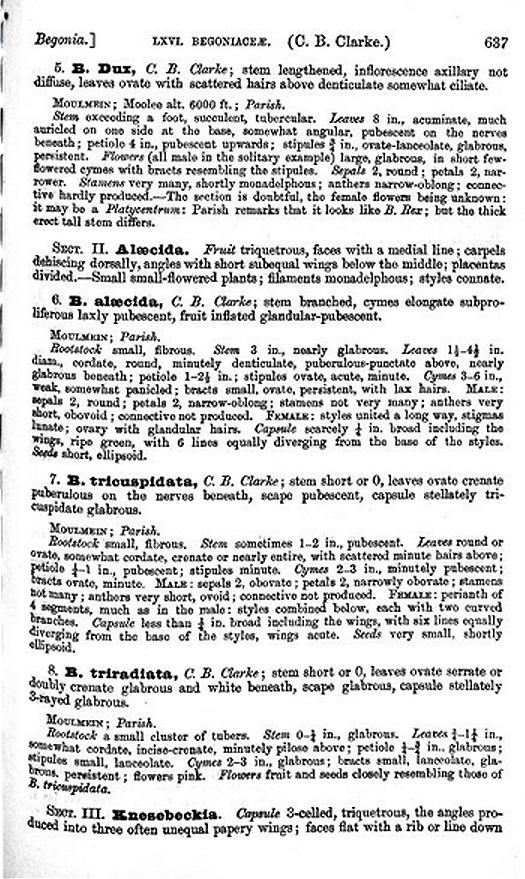Section Alicida C.B. Clarke The flora of British India 2, page 637 (1879),
Petites plantes vivaces terrestres, rhizomateuses ou tubéreuses, tiges herbacées, stipules non persistantes, feuilles glabres ou pubescentes, alternes, symétriques, non peltées, nervures palmées, inflorescences axillaires et terminales bisexuées à petites fleurs blanches ou roses, fruits à trois loges, chacune avec une ligne médiane, carpelles déhiscentes dorsalement, ailes courtes aux angles, placentas divisés. En raison du peu d’espèce de cette section, les caractères, notamment des fleurs, sont encore peu connus.
B. alicida C.B. Clarke (Birmanie, Thaïlande) Espèce décrite par Charles Baron Clarke en 1879 sous le nom de Begonia alaecida dans The Flora of British India volume 2, page 637 de Joseph Dalton Hooker. Plante arbustive ramifiée, feuilles cordées, rondes, denticulées, pubescentes et ponctuées au dessus, presque glabres au revers. Inflorescences en cymes, faiblement paniculées, bractées persistantes avec quelques poils.
B. tricupidata C.B. Clarke (Birmanie, Chine) Espèce décrite par Charles Baron Clarke en 1879 dans The Flora of British India volume 2, page 637 de Joseph Dalton Hooker. Plante compacte aux feuilles rondes ou ovales, crénelées, aux nervures pubescentes au revers. Petites inflorescences en cymes.
B. triradiata C.B. Clarke (Birmanie, Chine) Espèce décrite par Charles Baron Clarke en 1879 dans The Flora of British India volume 2, page 637 de Joseph Dalton Hooker. Plante compacte, parfois tubéreuse, aux feuilles cordées, ovales, crénelées ou incisées, avec de petits poils au revers. Petites inflorescences en cymes de fleurs roses.
B. vagans Craib (Thaïlande) Espèce décrite en 1930 par William Grant Craib dans Bulletin of Miscellaneous Information, Royal Gardens, Kew page 419. Plante rampante à feuilles en forme de fer de lance.
Section Alicida C.B. Clarke The Flora of British India 2, page 637 (1879),
Small perennial terrestrial, rhizomatous or tuberous plants, herbaceous stems, non-persistent stipules, hairless or pubescent leaves, alternate, symmetrical, unpeltate, webbed veins, axillary and terminal bisexual inflorescences with small white or pink flowers, fruits with three cells, each with a median line, dorsally dehiscent carpels, short wings at the corners, divided placentas. Due to the lack of species in this section, characters, including flowers, are still poorly known.
B. alicida C.B. Clarke (Burma, Thailand) Species described by Charles Baron Clarke in 1879 as Begonia alaecida in The Flora of British India 2, page 637 by Joseph Dalton Hooker. Branched shrubby plant, leaves cordate, round, denticulate, pubescent and punctuated above, almost glabrous on the reverse. Inflorescences in cymes, weakly paniculate, persistent bracts with some hairs.
B. tricupidata C. B. Clarke (Burma, China) Species described by Charles Baron Clarke in 1879 in The Flora of British India 2, page 637 by Joseph Dalton Hooker. Compact plant with round or ovate leaves, crenate, with pubescent veins on the underside. Small inflorescences in cymes.
B. triradiata C. B. Clarke (Burma, China) Species described by Charles Baron Clarke in 1879 in The Flora of British India 2, page 637 by Joseph Dalton Hooker. A compact plant, sometimes tuberous, with cordate, oval, crenate or incised leaves, with small hairs on the underside. Small inflorescences in cymes of pink flowers.
B. vagans Craib (Thailand) Species described in 1930 by William Grant Craib in Bulletin of Miscellaneous Information, Royal Gardens, Kew page 419. Spider-leafed creeping plant.

Sources Bibliographiques
The sections of Begonia including descriptions, keys and species lists (Studies in Begoniaceae VI) J. Doorenbos, M.S.M. Sosef & J.J.F.E. de Wilde